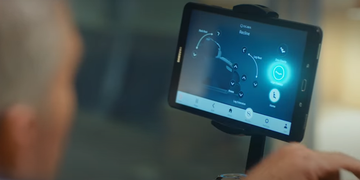Chronic back pain is a common ailment affecting an estimated 16 million Americans each year. These ailments can range from slight discomfort to debilitating pain but often stem from two sources: sciatica and piriformis syndrome. On the surface, sciatica vs piriformis syndrome seems to be exceptionally similar in how and where the pain is felt, however, the differences between the two highlight very different pain catalysts that require different approaches to treatment.
Today, we’re exploring piriformis syndrome vs sciatica to help you understand the differences between these two conditions, the most commonly-affected groups for each, and common treatment methods. As always, consult your doctor for an accurate diagnosis and to develop a treatment plan before beginning any new health routine.
Piriformis Syndrome vs Sciatica: Which Do I Have?
Piriformis syndrome and sciatica are two distinct conditions that are often confused due to their similar symptoms involving pain in the buttocks and down the leg. However, they have different underlying causes and require different approaches for diagnosis and treatment.
Piriformis Syndrome
Piriformis syndrome occurs when the piriformis muscle, a small muscle located deep in the buttock, becomes tight, inflamed, or irritated, leading to compression of the sciatic nerve. The sciatic nerve is the longest nerve in the body, running from the lower back, through the buttocks, and down the back of each leg. When the piriformis muscle irritates the sciatic nerve, it can result in symptoms that resemble sciatica.
Sciatica
Sciatica, on the other hand, may not be a condition itself but rather a symptom of an underlying problem. Symptoms of sciatica are often a result of a herniated or bulging disc in the lumbar spine. When a disc presses on the sciatic nerve, it leads to the characteristic pain that extends from the lower back through the buttocks and down the leg. Comparing sciatica vs piriformis syndrome, you’ll see sciatica can possibly affect both legs and typically causes more severe pain due to compression of the nerve root.
Common Symptoms of Piriformis Syndrome vs Sciatica
Another reason it may be difficult to determine if you’re experiencing piriformis syndrome vs sciatica is that some of their symptoms overlap. Because of this, it’s vital that you speak to your doctor right away if you’re experiencing any symptoms in order to get an accurate diagnosis and appropriate treatment plan.
To help you differentiate piriformis syndrome vs sciatica, an understanding of the nuanced differences between their symptoms is needed:
Symptoms of Piriformis Syndrome
- Pain in the buttocks that is almost always one-sided.
- Pain radiating down the back of the leg, usually stopping at the knee.
- Tenderness in the buttock area.
- Aggravation of pain after sitting for extended periods or performing activities that engage the piriformis muscle.
Symptoms of Sciatica
- Shooting pain down the leg that often reaches the foot or toes.
- Numbness, tingling, or weakness in the leg or foot.
- Pain worsens with activities that increase pressure on the spine, such as coughing or sneezing.
- Rarely, though occasionally, symptoms of sciatica vs piriformis syndrome may be felt on both sides.
Identifying Differences Between Piriformis Syndrome vs Sciatica
Beyond the nuanced symptoms of piriformis syndrome vs sciatica, there are other helpful indicators that may help you determine which you’re experiencing. While a medical expert is needed for a proper diagnosis, learning to identify differences between sciatica vs piriformis syndrome can help you be more prepared for that conversation.
Some factors to help you identify piriformis syndrome vs sciatica include:
Pain distribution: When it comes to piriformis syndrome vs sciatica, pain from the former usually stops at the knee whereas sciatica pain continues down the leg to the foot or toes.
Aggravating factors: Pain from piriformis syndrome vs sciatica often worsens after prolonged sitting or specific movements that engage the piriformis muscle. Sciatica, on the other hand, can worsen with activities that increase pressure on the spine.
Underlying causes: Comparisons of sciatica vs piriformis syndrome shows sciatica is typically caused by compression of the sciatic nerve due to a herniated or bulging disc in the spine, whereas piriformis syndrome involves irritation of the nerve by the piriformis muscle.
Examining piriformis syndrome vs sciatica shows each can affect individuals of all ages, but may be more prevalent in certain age groups. For example, piriformis syndrome often affects active individuals, athletes, or those at risk of repetitive motion injuries involving constant movement of the piriformis muscle. Those who sit for prolonged periods of time (whether it be for work or a sedentary lifestyle), however, may also face an increased risk of piriformis syndrome. Sciatica, on the other hand, is more common in adults between the ages of 30 and 50 and is sometimes related to age-related degenerative changes in the spine.
When it comes to the length or frequency of pain episodes from sciatica vs piriformis syndrome, it varies from person to person depending on the severity of the condition and how well it is managed. Mild cases of piriformis syndrome or sciatica may resolve with conservative treatments within a few weeks, while more severe cases could lead to chronic pain or recurrent episodes that require more advanced treatment options.
Treating Sciatica vs Piriformis Syndrome
The approach to treating piriformis syndrome vs sciatica shows the importance of not lumping them into one diagnosis. In fact, what may work as an effective treatment for one may actually exacerbate the symptoms of the other.
Piriformis Syndrome Treatment
Rest: Patients with piriformis syndrome are often recommended to rest and avoid activities that may aggravate symptoms. Avoiding activities that engage the piriformis muscle can help reduce irritation and inflammation.
Physical therapy: Physical therapy plays a significant role in managing piriformis syndrome. Stretching and strengthening exercises are prescribed to improve flexibility and strength in the affected area, thereby reducing pressure on the sciatic nerve.
Ice or heat therapy: Applying heat or ice packs to the buttock area can help alleviate pain and reduce inflammation. Individuals using recovery tools like a heated massage chair may combine treatment methods like the benefits of heat therapy with therapeutic massage techniques.
Medications: Over-the-counter nonsteroidal anti-inflammatory drugs (NSAIDs) or muscle relaxants may be recommended to relieve pain and muscle spasms.
Sciatica Treatment
Pain management: The initial focus of sciatica treatment is to manage pain. Over-the-counter pain relievers such as NSAIDs may be recommended.
Physical therapy: Physical therapy is commonly prescribed to improve flexibility and strength in the back and abdominal muscles, which can help alleviate pressure on the sciatic nerve and alleviate or prevent sciatic nerve pain from occurring.
Epidural steroid injections: In more severe cases of sciatica, your doctor may recommend epidural steroid injections. These injections deliver anti-inflammatory medication directly into the epidural space, reducing inflammation and alleviating pain.
Lifestyle changes: Maintaining a healthy lifestyle with regular exercise, maintaining a healthy weight, and practicing good posture are all beneficial for managing sciatica symptoms.
While there are different approaches to treating piriformis syndrome vs sciatica, some options may benefit both conditions. For example, SL-track massage chairs give you the benefits of massage therapy at home on your schedule and without the added time or financial stress factors of fitting in regular traditional massage appointments. These luxury massage chairs continue beyond the lower back to the glutes and top of the hamstrings, gently working all the areas that may benefit both conditions.
Other massage chair features like heat therapy and zero gravity reclining capabilities take your recovery even further, helping enhance how the body heals itself while deepening relaxation. The sheer number of different types of massage available at the touch of a button means you can choose what you need every time. There are even AI massage chairs that use two types of body scanning technology to provide a bespoke experience for each use.
Although piriformis syndrome and sciatica share similar symptoms, they have distinct underlying causes and require different approaches to diagnosis and treatment. It’s essential for individuals experiencing symptoms of piriformis syndrome vs sciatica to seek professional medical advice from their doctor for an accurate diagnosis and treatment plan. Each case is unique, and the appropriate treatment will depend on the severity of the condition and the individual's specific needs.
Bonus: How does a massage chair help with sciatica treatment? Learn more about using these recovery tools for sciatica next.





